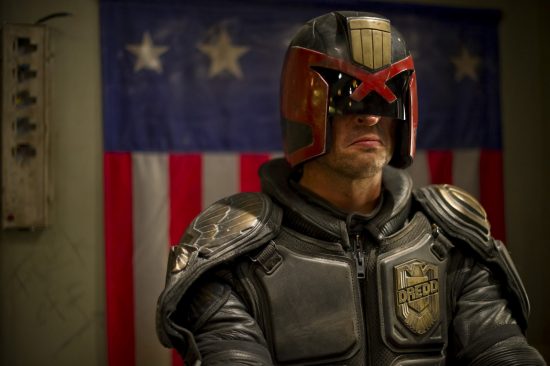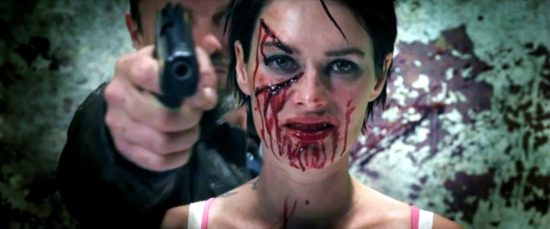Borders and Dredd – A Short Analysis of Abjection in Dredd 3D
Possibly some slight spoilers ahead.
In the early 1980s, Bulgarian-French philosopher and sociologist Julia Kristeva’s Power of Horror: An Essay on Abjection (1980) outlined the body’s relationship with borders. Kristeva argued that the importance of maintaining borders is an exertion to keep a sense of self or identity, arguing that the abject is neither subject nor object, rather, it is the threat to subjectivity. She stated that “the abject is not an ob-ject facing me, which I can name or imagine” (1982: 1), instead she describes it as the threat to one’s sense of boundary, whether ego or physical.
Abjection is often related to themes of body horror, particularly in film, either in narrative or emblematic iconography. Kristeva argues that for the body to be fully symbolic of itself, it must be aware of the “clean and proper” (Kristeva, 1982: 102). She argues that there is a fascination with the abject and in turn a fascination in disgust that links abjection to voyeurism. The loss of bodily fluids becomes a space of fascination and repulsion for the spectator, particularly in the macabre environment of the horror movie. The expulsion of bodily fluids includes blood, sweat, puss, vomit, tears, urine and faeces. Additionally, abjection is often related to the maternal body, particularly the process of childbirth, and in particular with death. Some examples of films featuring the abject are: Alien (Ridley Scott, 1979); The Fly (David Cronenberg, 1986); Girl, Interrupted (James Mangold, 1999); Dune (David Lynch, 1984); RoboCop (Paul Verhoeven, 1987) and The Brood (David Cronenberg, 1979), and although abjection is not solely limited to horror or science fiction, it is these genres that significantly more often contain thematic elements of the abject within the narrative.
Dredd 3D (Pete Travis, 2012) is an ultra-violent science-fiction thriller based on the popular character from the long-running British magazine 2000 AD. The film follows Dredd (Karl Urban) as he and rookie law enforcer Judge Anderson (Olivia Thirlby) track down a suspected drug gang following a triple homicide at Peach Trees mega-block, home to some 70,000 residents including drug lord and gang-leader Ma-Ma (Lena Headey). While trapped inside the block, Dredd and Anderson – both of whom carry the role of judge, jury and executioner – embark on a series of bloody killings in their search for Ma-Ma. The film allows for spectacularly shot examples of gore and violence, which illustrate the abject intermittently from start to finish.
Throughout the course of the film, Dredd and Anderson are frequently shown killing criminals in the most violent fashion. Shortly after initially arriving in Peach Trees, the team of two discover the drug gang in an apartment, and quickly gain entry by blowing the door with an explosive device. Once inside, the spectator is subject to a series of graphic shots showing Dredd firing round after round of bullets, often in slow motion and close-up, into the criminals, emphasising penetration of the body. One particular shot shows a bullet piercing a gang member through the face, entering one cheek, through his mouth and emerging through the other side, which highlights the crude and regularly aggressive depiction of carnage. Added to the effect of slow motion is the fact that the film is presented in 3D, which further underscores the brutal nature of the enforcers by allowing the spectator to absorb the rich details in the butchery of the criminals.
tly following her introduction, it is revealed early on that the character of Anderson is a mutant with the ability to mind read. Annie Murphy Paul of Psychology Today argues,
ding [is] a critical human skill. It’s the way we make sense of other people’s behavior and decide on our own next moves. Mind reading enables us to negotiate, compete, cooperate, and achieve emotional closeness with others. It lets us figure out when we’re being manipulated or seduced. It’s how we know when someone finds our jokes hilarious or is humoring us out of politeness. Mind-reading ability is perhaps the most urgent element of social intelligence.(Paul, 2007: online)
Following the siege at the apartment, Dredd and Anderson arrest a henchman of Ma-Ma’s named Kay (Wood Harris). While captured, Anderson uses her mind reading skills to telepathically communicate with Kay, psychologically shifting herself into his thoughts. The act displays the utmost of intrusion, as Anderson invades his mind and gains access to his most personal space. While the body would customarily act at the border retaining an individual’s private thoughts, Anderson acts as a threat to Kay’s border by psychologically invading the inside of his head. She quickly manipulates his mind and acquires the information she needs during a crude exchange of thoughts, resulting in Kay urinating himself, an example of the body attempting to maintain its border by expelling the unclean while in a state of shock and confusion. Kristeva comments on preserving bodily margins, stating that
It is thus not lack of cleanliness or health that causes abjection but what disturbs identity, system, order. What does not respect borders, positions, rules. The in-between. The ambiguous, the composite. The traitor, the liar, the criminal with a good conscience.
(Kristeva, 1982: 4)
While the abject is represented in the psychology of Anderson, the sense of self and identity is most significant in the manifestation of the characters Dredd and Ma-Ma. Unlike the previous cinematic effort by Sylvester Stallone, Urban’s Dredd wears his helmet at all times, never revealing his face to anyone – a tool he uses to preserve his own status. Additionally, he is never seen out of uniform, establishing an unfailing authority to not only the audience, but also to the citizens of Peach Trees and the gang members within. The uniform helps to support Dredd as an authoritative figure, and to lose his uniform and helmet is to lose his sense of identity. In opposition, Anderson is in large part seen without her helmet, as she claims it obstructs her telepathic ability. This situates her as vulnerable, while at the same time providing an important element of the character for the spectator to focus on, her face, unlike the anonymous façade of Dredd.
The character of Ma-Ma broadens the physical manifestation of the abject, while introducing themes of the rotting corpse. Ma-Ma represents the quintessence of the ‘monstrous-feminine’ – the unison of female formation and malevolence. Film theorist Barbara Creed utilises Kristeva’s model of abjection in her work on the monstrous-feminine, arguing that “in Kristeva’s view, woman is specifically related to polluting objects which fall into two categories: excremental and menstrual” (Creed, 1993: 10). While Dredd is not a horror film per say, it does contain images typical of the horror genre, particularly in the emergence of skinned bodies and bloody murders, relating the film to the corpse. The imposing force behind these murders is Ma-Ma, the personification of the monstrous and the maternal which bonds her with Kristeva’s theory of the abject. While not overtly displaying sexual yearnings or maternal instinct, her name “Ma-Ma” appears as a play on words (“mama” or “mother”). Upon her introduction, Ma-Ma is shown taking a bath (the purifying act of making the body clean), while at the same time inhaling the drug Slo-Mo. In close-up, the spectator is witness to a large scar on one side of her face. It is later revealed that the scar is the result of an attack during her days as a prostitute. In flashback, the scar is seen oozing blood, whereas throughout the rest of the film, a scar has formed knitting the skin together in order to keep the blood from leaking. Furthermore, her teeth are blackened and rotting, which indicates that Ma-Ma is decayed on the inside further situating the skin as border and suggesting elements of the rotting corpse.
Supplemental to abject physiology of characters in film, the abject can also be linked to geography. Mega City One houses over 800 million citizens, and is situated within a vast, baron wasteland in post-apocalyptic America. High walls around the perimeter of the city not only prevent infringement from outsiders, but also prevent the citizens from leaving, protecting the city and its inhabitants from external elements. Within the walls, huge tower blocks with the capacity of housing thousands of people dominate the skyline and loom menacingly over the city streets, Peach Trees being one. Under Ma-Ma’s command, large shutters come down over the exits and windows, leaving Dredd and Anderson trapped inside along with the 70,000-strong residents. Not only this, but daylight is also obstructed, leaving the building lit only the dim bulbs that sparsely line the labyrinthine corridors. This provides Ma-Ma and her gang with the upper hand, not only preventing the judges from leaving, but also from backup arriving. Furthermore, Ma-Ma controls the network of security surveillance, watching the judges on camera, which furthers the notion of voyeurism, which is often seen from the audience from a point-of-view perspective, positioning the spectator as I/eye.
The examples in this article provide specific evidence that links Dredd with Kristeva’s model of the abject. Abjection is evident in the manifestation of the characters Dredd, Anderson, Kay and Ma-Ma. It is evident in the blood-splattered killings, crudely skinned bodies, the psychology of mind reading and specific elements of mise-en-scène, most significantly the in the characters’ semiotics. The abject also manifests itself in the geographical colonialism of the film, in giving Mega City One walls to prevent outsiders from entering, reinforcing the thematic elements of borders and maintaining identity by protecting the citizens of the city. Whether it be an individual identifying their own subjectivity, such as Judge Dredd using his uniform and helmet as an illustration of his own sense of self, or the community of Mega City One uniting in the deterrence of outside threat, the conception of the border protecting the ‘self’ from the ‘Other’ is an coherently stable theme within the narrative of Dredd 3D.
Bibliography:
Creed, B., 1993. The Monstrous Feminine. Oxon: Routledge
Kristeva, J., 1982. The Powers of Horror. New York: Columbia University Press.
Paul, A., 2007. Mind Reading [online]. Available at:
<http://www.psychologytoday.com/articles/200708/mind-reading> [Accessed on 10 September 2012].
Filmography:
Alien, 1979. [Film] Directed by Ridley Scott. USA: 20th Century Fox
Dredd, 2012. [Film] Directed by Pete Travis. UK: Lionsgate
Dune, 1984. [Film] Directed by David Lynch. USA: Universal Pictures
RoboCop, 1987. [Film] Directed by Paul Verhoeven. United States: Orion Pictures
The Brood, 1979. [Film] Directed by David Cronenberg. Canada: New World-Mutual
The Fly, 1986. [Film] Directed by David Cronenberg. United States: 20th Century Fox











